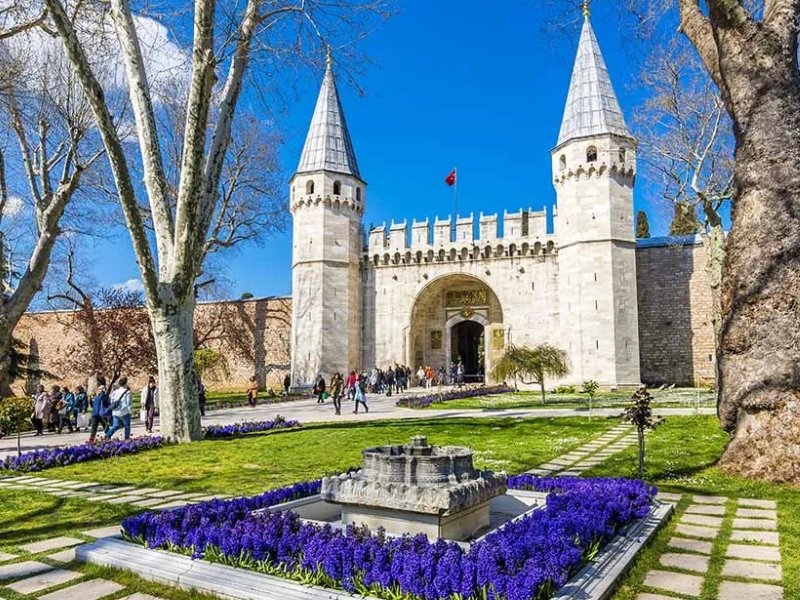Located in the heart of Istanbul, Topkapi Palace stands as one of the most significant and majestic landmarks of the city. Once the residence of Ottoman sultans for nearly 400 years, this grand palace now serves as the Topkapi Palace Museum, offering visitors a unique insight into the opulence, history, and grandeur of the Ottoman Empire. The museum’s vast collections, stunning architecture, and historical significance make it one of Istanbul’s most visited attractions.
A Rich History Behind Topkapi Palace
The Topkapi Palace was commissioned by Sultan Mehmed the Conqueror shortly after his victory over Constantinople in 1453. Originally serving as the royal residence and the administrative center of the Ottoman Empire, the palace remained the home of sultans and their families until the mid-19th century when Sultan Abdülmecid I moved to the more modern Dolmabahçe Palace.
Topkapi Palace covers a large area of land, situated on the Seraglio Point, a promontory that overlooks the Golden Horn, Bosphorus Strait, and Sea of Marmara. The palace complex consists of several courtyards, grand halls, pavilions, and gardens that were meticulously designed to reflect the power and wealth of the Ottoman dynasty. Today, Topkapi Palace is recognized as a UNESCO World Heritage site and is an essential stop for anyone interested in the rich history of Istanbul and the Ottoman Empire.
The Architecture: A Blend of Cultures and Eras
The architecture of Topkapi Palace is a blend of various cultural influences, including Islamic, Byzantine, and Persian elements, which were incorporated over centuries. The palace’s unique design reflects the diverse artistic heritage of the Ottoman Empire, incorporating large courtyards, monumental gates, and intricate tile work.
One of the most striking features of the palace is its Harem, a secluded section of the palace where the sultan’s family, concubines, and female servants resided. The Harem is a symbol of the empire’s intricate hierarchy and private world. Its opulent rooms, delicate tiles, and richly painted ceilings provide an intimate glimpse into the lifestyle of the royal court.
Another remarkable structure within the palace is the Imperial Gate, which is adorned with gold and marble, leading into the inner courtyards. The Palace Kitchens are equally impressive, showcasing the grand scale of meals served to the royal family and their guests, with over 1,000 chefs employed in their heyday.
Must-See Highlights of Topkapi Palace Museum
1. The Harem: Secrets of the Sultan’s Private Life
The Harem is one of the most fascinating and mysterious sections of the palace. It housed the sultan’s family, including his mother, wives, daughters, and concubines. Visitors can explore the ornate rooms and chambers, which are decorated with intricate mosaics, tiles, and precious carpets.
The Sultan’s Private Quarters, the Queen Mother’s Chamber, and the Concubines’ Rooms all reveal fascinating details about the daily life of the royal family. The Harem is a place steeped in intrigue, as it was not only the home of the sultan’s women but also the center of political power, as many of the women held significant influence over the sultan and the empire’s decisions.
2. The Imperial Treasury: A Display of Royal Wealth
One of the most impressive collections housed in the Topkapi Palace Museum is the Imperial Treasury. Here, visitors can marvel at the grandeur and extravagance of the Ottoman rulers, with a collection that includes priceless jewels, gold and silverware, intricate weapons, and royal gifts. The Topkapi Dagger, adorned with large emeralds and diamonds, is one of the most famous pieces in the collection.
Among the treasures, the Spoonmaker’s Diamond, a 86-carat gem, is an extraordinary highlight. Its history and the legend behind its name are just as fascinating as its sheer size and beauty.
3. The Sacred Relics: Relics of the Prophet Muhammad
One of the most revered sections of the Topkapi Palace Museum is the Sacred Relics room, which houses some of the most sacred relics of Islamic history. This collection includes items that are said to have belonged to the Prophet Muhammad, including his sword, cloak, tooth, and footprint. These relics, along with other religious artifacts, are displayed in a richly decorated chamber, providing visitors with a deeper connection to Islamic heritage and the Ottoman Empire’s strong religious ties.
4. The Pavilion of the Holy Mantle and the Privy Chamber
The Pavilion of the Holy Mantle is another fascinating area within the palace, where the Mantle of the Prophet Muhammad is said to be preserved. This, along with the Privy Chamber, houses significant Ottoman-era manuscripts, royal edicts, and personal items of sultans and their courts, showcasing the cultural and political power of the Ottoman Empire.
Gardens and Courtyards: A Place of Tranquility
The Topkapi Palace is surrounded by stunning gardens that offer a peaceful escape from the hustle and bustle of Istanbul. These well-maintained gardens are adorned with fountains, pavilions, and lush greenery. The First Courtyard is open to the public for free, and it features beautiful walks lined with trees, offering a glimpse into the life of the sultans. Visitors can also explore the Second and Third Courtyards, where many of the palace’s most important buildings, including the Imperial Treasury, the Harem, and the Sultan’s Audience Hall, are located.
Conclusion: A Window into the Past
A visit to the Topkapi Palace Museum is like stepping back in time, offering a glimpse into the grandeur and complexity of the Ottoman Empire. From the opulent treasures in the Imperial Treasury to the serene gardens surrounding the palace, Topkapi Palace tells the story of a dynasty that ruled over much of the world for centuries. Whether you are fascinated by Ottoman history, architecture, or Islamic artifacts, the Topkapi Palace Museum offers a once-in-a-lifetime opportunity to immerse yourself in the culture and history of one of the world’s most powerful empires.

